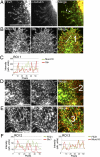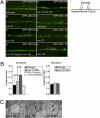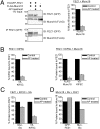Phosphorylation-regulated axonal dependent transport of syntaxin 1 is mediated by a Kinesin-1 adapter
- PMID: 22451907
- PMCID: PMC3326461
- DOI: 10.1073/pnas.1113819109
Phosphorylation-regulated axonal dependent transport of syntaxin 1 is mediated by a Kinesin-1 adapter
Abstract
Presynaptic nerve terminals are formed from preassembled vesicles that are delivered to the prospective synapse by kinesin-mediated axonal transport. However, precisely how the various cargoes are linked to the motor proteins remains unclear. Here, we report a transport complex linking syntaxin 1a (Stx) and Munc18, two proteins functioning in synaptic vesicle exocytosis at the presynaptic plasma membrane, to the motor protein Kinesin-1 via the kinesin adaptor FEZ1. Mutation of the FEZ1 ortholog UNC-76 in Caenorhabditis elegans causes defects in the axonal transport of Stx. We also show that binding of FEZ1 to Kinesin-1 and Munc18 is regulated by phosphorylation, with a conserved site (serine 58) being essential for binding. When expressed in C. elegans, wild-type but not phosphorylation-deficient FEZ1 (S58A) restored axonal transport of Stx. We conclude that FEZ1 operates as a kinesin adaptor for the transport of Stx, with cargo loading and unloading being regulated by protein kinases.
Conflict of interest statement
The authors declare no conflict of interest.
Figures






Similar articles
-
UNC-16/JIP3 and UNC-76/FEZ1 limit the density of mitochondria in C. elegans neurons by maintaining the balance of anterograde and retrograde mitochondrial transport.Sci Rep. 2018 Jun 12;8(1):8938. doi: 10.1038/s41598-018-27211-9. Sci Rep. 2018. PMID: 29895958 Free PMC article.
-
Phosphorylation of FEZ1 by Microtubule Affinity Regulating Kinases regulates its function in presynaptic protein trafficking.Sci Rep. 2016 Jun 1;6:26965. doi: 10.1038/srep26965. Sci Rep. 2016. PMID: 27247180 Free PMC article.
-
The Caenorhabditis elegans Kinesin-3 motor UNC-104/KIF1A is degraded upon loss of specific binding to cargo.PLoS Genet. 2010 Nov 4;6(11):e1001200. doi: 10.1371/journal.pgen.1001200. PLoS Genet. 2010. PMID: 21079789 Free PMC article.
-
"JIP"ing along the axon: the complex roles of JIPs in axonal transport.Bioessays. 2008 Jan;30(1):10-4. doi: 10.1002/bies.20695. Bioessays. 2008. PMID: 18081006 Review.
-
Neurotransmitter release mechanisms studied in Caenorhabditis elegans.Cell Calcium. 2012 Sep-Oct;52(3-4):289-95. doi: 10.1016/j.ceca.2012.03.005. Epub 2012 Apr 20. Cell Calcium. 2012. PMID: 22521667 Review.
Cited by
-
HIV-1 capsids bind and exploit the kinesin-1 adaptor FEZ1 for inward movement to the nucleus.Nat Commun. 2015 Mar 30;6:6660. doi: 10.1038/ncomms7660. Nat Commun. 2015. PMID: 25818806 Free PMC article.
-
A kinesin-1 adaptor complex controls bimodal slow axonal transport of spectrin in Caenorhabditis elegans.Dev Cell. 2023 Oct 9;58(19):1847-1863.e12. doi: 10.1016/j.devcel.2023.08.031. Epub 2023 Sep 25. Dev Cell. 2023. PMID: 37751746 Free PMC article.
-
Structural analysis of intermolecular interactions in the kinesin adaptor complex fasciculation and elongation protein zeta 1/ short coiled-coil protein (FEZ1/SCOCO).PLoS One. 2013 Oct 7;8(10):e76602. doi: 10.1371/journal.pone.0076602. eCollection 2013. PLoS One. 2013. PMID: 24116125 Free PMC article.
-
Schwannomin-interacting Protein 1 Isoform IQCJ-SCHIP1 Is a Multipartner Ankyrin- and Spectrin-binding Protein Involved in the Organization of Nodes of Ranvier.J Biol Chem. 2017 Feb 10;292(6):2441-2456. doi: 10.1074/jbc.M116.758029. Epub 2016 Dec 15. J Biol Chem. 2017. PMID: 27979964 Free PMC article.
-
Phosphorylation of multiple sites within an acidic region of Alcadein α is required for kinesin-1 association and Golgi exit of Alcadein α cargo.Mol Biol Cell. 2017 Dec 15;28(26):3844-3856. doi: 10.1091/mbc.E17-05-0301. Epub 2017 Nov 1. Mol Biol Cell. 2017. PMID: 29093024 Free PMC article.
References
Publication types
MeSH terms
Substances
LinkOut - more resources
Full Text Sources
Molecular Biology Databases

